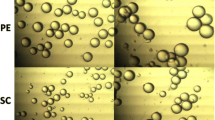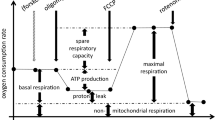Abstract
Two metabolic pathways of the white adipocytes (i.e. de novo lipogenesis and lipolysis) require mitochondria functionality. In this report, the oxidative capacity of two white adipose tissues of rat and their respective isolated adipocytes were evaluated. Two major white fat pads, namely inguinal and epididymal tissues, were chosen as subcutaneous and visceral adipose tissues, respectively. The mitochondrial content of these tissues was estimated using cytological and biochemical analysis. Electron microscopy analysis showed higher mitochondrial density in epididymal than in inguinal adipocytes. The mitochondrial DNA content and mitochondrial enzymatic equipment were also higher in the former than in the latter tissue. A positive correlation between two mitochondrial enzymatic activities, namely cytochrome c oxidase and citrate synthase, and the mtDNA content of adipose tissue was reported. Moreover, NRF1 protein, which belongs to the transcriptional activator family and is thought to be involved in mitochondrial biogenesis regulation, was present in higher proportions in nuclei isolated from epididymal cells than in those from inguinal cells. Finally, greater abundance of mitochondria in epididymal tissue is in agreement with higher cytochrome c oxidase activity as well as increased respiration (i.e. basal and noradrenaline-stimulated) of adipocytes isolated from epididymal tissue as compared to adipocytes isolated from inguinal tissue. Therefore, white adipose tissue appears as a heterogeneous organ with marked variation in mitochondrial content depending on its anatomical location. (Mol Cell Biochem 267: 157–166, 2004)
Similar content being viewed by others

References
Kopecky J, Rossmeisl M, Flachs P, Bardova K, Brauner P: Mitochondrial uncoupling and lipid metabolism in adipocytes. Biochem Soc Trans 29: 791–797, 2001
Sorbris R, Monti M, Nilsson-Ehle P, Wadso I: Heat production by adipocytes from obese subjects before and after weight reduction. Metabolism 10: 973–978, 1982
Hallgren P, Korsback S, Sjöström L: Measurements of adipose tissue respiration in a closed chamber using an oxygen sensor: Methodological considerations. J Lipid Res 27: 996–1005, 1986
Klaus S, Ely M, Encke D, Heldmaier G: Functional assessment of white and brown adipocyte development and energy metabolism in cell culture. Dissociation of terminal differentiation and thermogenesis in brown adipocytes. J Cell Sci 108: 3171–3180, 1995
Hartman AD, Christ DW: Effect of cell size, age and anatomical location on the lipolytic response of adipocytes. Life Sci 22: 1087–1096, 1978
Hauner H, Pfeiffer EF: Regional differences in glucocorticoid action on rat adipose tissue metabolism. Horm Metab Res 21: 581–582, 1989
Portillo MP, Villaro JM, Torres MI, Macarulla MT: In vivo lipolysis in adipose tissue from two anatomical locations measured by microdialysis. Life Sci 67: 437–445, 2000
Jamdar SC: Glycerolipid biosynthesis in rat adipose tissue. Influence of adipose-cell size and site of adipose tissue on triacylglycerol formation in lean and obese rats. Biochem J 170: 153–160, 1978
Atzmon G, Yang XM, Muzumdar R, Ma XH, Gabriely I, Barzilai N: Differential gene expression between visceral and subcutaneous fat depots. Horm Metab Res 34: 622–628, 2002
Prunet-Marcassus B, Moulin K, Carmona MC, Villarroya F, Penicaud L, Casteilla L: Inverse distribution of uncoupling proteins expression and oxidative capacity in mature adipocytes and stromal-vascular fractions of rat white and brown adipose tissues. FEBS Lett 464: 184–188, 1999
Carr A, Samaras K, Burton S, Law M, Freund J, Chisholm DJ, Cooper DA: Asyndrome of peripheral lipodystrophy, hyperlipidaemia and insulin resistance in patients receiving HIV protease inhibitors. AIDS 12: F51–F58, 1998
Brinkman K, Smeitink JA, Romijn JA, Reiss P: Mitochondrial toxicity induced by nucleoside analogue reverse transcriptase inhibitors is a key factor in the pathogenesis of antiretroviral therapy related lipodystrophy. Lancet 354: 1112–1115, 1999
Saint-Marc T, Partisani M, Poizot-Martin I, Bruno F, Rouviere O, Lang JM, Gastaut JA, Touraine JL: A syndrome of peripheral fat wasting (lipodystrophy) in patients receiving long-term nucleoside analogue therapy. AIDS 13: 1659–1667, 1999
Rodbell M: Metabolism of isolated fat cells. Effect of hormone on fat metabolism and lipolysis. J Biol Chem 239: 375–380, 1964
Srere PA: Citrate synthase. Methods Enzymol. 13: 3–11, 1969
Trijbels JMF, Sengers RCA, Ruitenbeek W, Fisher JC, Bakkeren JAJM, Janssen AJM: Disorders of the mitochondrial respiratory chain: Clinical manifestations and diagnosis approach. Eur J Pediatr 148: 92–97, 1988
Rustin P, Chretien D, Bourgeron T, Gérard B, Rötig A, Saudubray JM, Munnich A: Biochemical and molecular investigations in respiratory chain deficiencies. Clin Chim Acta 228: 35–51, 1994
Wise LS, Green H: Participation of one isozyme of cytosolic glycerophosphate dehydrogenase in the adipose conversion of 3T3 cells. J Biol Chem 254: 273–275, 1979
Bukowiecki LJ, Follea N, Lupien J, Paradis A: Metabolic relationships between lipolysis and respiration in rat brown adipocytes. J Biol Chem 256: 12840–12848, 1981
Labarca C, Paigen K: A simple, rapid, and sensitive DNA assay procedure. Anal Biochem 102: 344–352, 1980
James AM, Wei Y-H, Pang C-Y, Murphy, MP: Altered mitochondrial function in fibroblasts containing MELAS or MERRF mitochondrial DNA mutation. Biochem J 318: 401–407, 1996
Gregoire FM, Smas CM, Sul HS: Understanding adipocyte differentiation. Physiol Rev 78: 783–809, 1998
Virbasius JV, Scarpulla RC: Activation of the human mitochondrial transcription factor A gene by nuclear respiratory factors: A potential regulatory link between nuclear and mitochondrial gene expression in organelle biogenesis. Proc Natl Sci USA 91: 1309–1313, 1994
Lee C-H, Olson P, Evans RM: Lipid metabolism, metabolic diseases, and peroxisome proliferator-activated receptors. Endocrinology 144: 2201–2207, 2003
Bartness TJ, Hamilton JM, Wade GN, Goldman BD: Regional differences in fat pad responses to short days in Siberian hamsters. Am J Physiol 257: R1533–R1540, 1989
Pond CM, Mattacks CA: The effects of noradrenaline and insulin on lipolysis in adipocytes isolated from nine different adipose depots of guinea-pigs. Int J Obes 9: 609–618, 1991
Santos RF, Sztalryd C, Reaven G: Effect of anatomical site on insulin action and insulin receptor phosphorylation in isolated rat adipocytes. Int J Obes 11: 755–762, 1991
Digirolamo M, Fine JB, Tagra K, Rossmanith R: Qualitative regional differences in adipose tissue growth and cellularity in male Wistar rats fed ad libitum. Am J Physiol 274: R1460–R1467, 1998
Evans MJ, Scarpulla RC: Interaction of nuclear factors with multiple sites in the somatic cytochrome c promoter. Characterization of upstream NRF-1, ATF, and intron Sp1 recognition sequences. J Biol Chem 264: 14361–14368, 1989
Evans MJ, Scarpulla RC: NRF-1: A transactivator of nuclear-encoded respiratory genes in animal cells. Genes Dev 4: 1023–1034, 1990
Scarpulla RC: Nuclear control of respiratory chain expression in mammalian cells. J Bioenergy Biomembr 29: 109–119, 1997
Garesse R, Vallejo CG: Animal mitochondrial biogenesis and function: A regulatory cross-talk between two genomes. Gene 263: 1–16, 2001
Wang H, Hiatt W, Barstow TJ, Brass EP: Relationships between muscle mitochondrial DNA content, mitochondrial enzyme activity and oxidative capacity in man: Alterations with disease. Eur J Appl Physiol Occup Physiol 80: 22–27, 1999
Bentlage HA, Attardi G: Relationship of genotype to phenotype in fibroblast-derived transmitochondrial cell lines carrying the 3243 mutation associated with the MELAS encephalomyopathy: shift towards mutant genotype and role of mtDNA copy. Hum Mol Genet 5: 197–205, 1996
Van den Bogert C, De Vries H, Holtrop M, Muus P, Dekker HL, Van Galen M, Bolhuis P, Taanman JW: Regulation of the expression of mitochondrial proteins: relationship between mtDNA copy number and cytochrome-c oxidase activity in human cells and tissues. Biochim Biophys Acta 1144: 177–183, 1993
Shikuma CM, Hu N, Milne C, Yost F, Waslien C, Shimizu S, Shiramizu B: Mitochondrial DNA decrease in subcutaneous adipose tissue of HIV-infected individuals with peripheral lipoatrophy. AIDS 15: 1801–1809, 2001
Author information
Authors and Affiliations
Rights and permissions
About this article
Cite this article
Deveaud, C., Beauvoit, B., Salin, B. et al. Regional differences in oxidative capacity of rat white adipose tissue are linked to the mitochondrial content of mature adipocytes. Mol Cell Biochem 267, 157–166 (2004). https://doi.org/10.1023/B:MCBI.0000049374.52989.9b
Issue Date:
DOI: https://doi.org/10.1023/B:MCBI.0000049374.52989.9b



